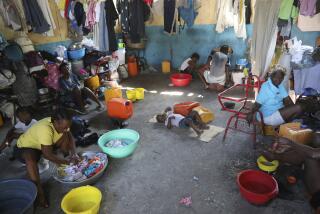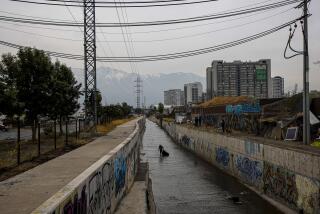In Haiti, Food Serves as Instrument of Control
- Share via
PETIONVILLE, Haiti — Homeless boys who sleep in the trampled shrubbery surrounding St. Peter’s Church used to earn their daily plate of rice and beans from a man they called Papa, a surly vagrant who carried a rock in one hand and a cellphone in the other.
The phone doesn’t ring much these days with assignments for the street kids, who earned a few gourdes for dragging chunks of cinderblock into the road to form a barricade in then-President Jean-Bertrand Aristide’s defense, or torching a pile of tires to turn away traffic. For now, at least, the odd jobs of destruction have disappeared.
“We don’t eat every day now,” 12-year-old Robinson Cherie said in a tone as matter-of-fact as if he were describing the weather. “We have to beg more now, and wash car windshields. When we get enough money to buy food is when we eat.”
Boys such as Robinson abound in the slums and shantytowns that sprawl along the mucky shallows of the Caribbean and up the eroded hillsides of this Port-au-Prince suburb perched above the sea. These lost, homeless boys number in the hundreds of thousands -- some orphaned, others abandoned, all vulnerable to gangland recruiters such as Papa simply because they need to eat.
Long outside the humanitarian relief network, the boys are not even counted among the half of Haiti’s 8.5 million people with chronic malnutrition. In a nation where mothers take their malnourished children to neighborhood clinics for monthly weighing and meager rations of rice, corn and beans, the plight of the street kids goes unrecorded.
But their abuse at the hands of those with the power to buy sustenance illustrates the depth of desperation in this nation where food has long been an instrument of control. The boys and their hunger remain a weapon in the hands of anyone willing to feed them.
Aristide’s Lavalas Party was believed to have paid the tab for strategic feeding of these legions of uneducated youths. Before Lavalas, support came from the brutal Tontons Macoutes secret police that enforced the Duvalier dictatorship. Who will next bankroll the feedings -- be they politicians, gangsters or drug dealers -- remains to be seen.
But manipulation through food will continue to determine the quality of life on the streets among the poor, whose allegiance is often a function of how full their stomachs are.
Jean-Daniel Jean-Baptiste, who was brought north from Jacmel to the roiling capital, Port-au-Prince, and dumped here when he was 9, is typical of the homeless youths lured into political enforcement gangs. Small for his 11 years, he says he never understood why Papa wanted them to set fires and build barricades.
“We just wanted the money so we could eat,” said the boy, who still hopes that his father will one day come to find him.
Jean-Daniel and his friends from the church courtyard all lost their mothers years ago and landed in the capital when traffickers -- some would call them slave traders -- brought them from the impoverished countryside to earn money to send home to their fathers and siblings. Unable to find work in a country suffering almost 70% unemployment, the children scrape together an existence by begging, running errands or inflicting political disruption.
The boys spend their wages of 10 or 20 gourdes (30 to 60 cents) on a daily bread roll and fried plantains or a dish of rice and beans, all hawked from battered street carts by women nearly as poor as their child patrons.
Although Robinson says he was unenthusiastic about setting fires for Papa, he and his friends in the churchyard seem open to whatever tasks will put food on their sidewalk table. Carrying chairs or tables for a church social, bringing ice to a hillside villa for a party, washing cars and repairing tire punctures for Western aid workers are all in their repertoire, as well as the political intimidation tactics taught by adults such as Papa.
Most Western aid workers were encouraged by their governments to leave Haiti in mid-February, when armed rebels seized control of the northern half of the country and threatened to march on the capital unless Aristide resigned and left the country.
Although some projects are likely to be revived in coming weeks if some calm takes hold, food production at isolated plantations, fish farms and orchards is likely to be reduced by security delays and disruptions.
With prices for scarce food on the rise and wages disappearing for those on the social fringes, all 23 health centers in Port-au-Prince monitored by the World Food Program were reporting a drastic increase in demand for aid since Aristide’s Feb. 29 departure, said Alejandro Chicheri, a spokesman for the U.N. agency in Haiti.
The wave of rebellion disrupted food deliveries to the north and commerce throughout the country, and the punitive ransacking and destruction instigated by Aristide supporters put thousands of the lowest wage earners out of work.
Looting and pillaging of the port terminal also deprived merchants of food supplies meant for private sale and consumption, raising the prospect of shortages in coming weeks, even on the commercial market.
“Prices have risen about 30% because of the disruptions, and that pushes more people into dependence on foreign aid,” Chicheri said. “This is a country of poor people who have very few coping mechanisms. Fifty percent of the population is chronically malnourished, and it’s not just food. Many also have no access to clean water.”
At the Canape Vert health center, women and children thronged the two-story shack recently in a desperate rush to get food rations after the post-Aristide anarchy closed the center for more than a week.
“We received food to distribute for 650, and nearly 1,200 came,” said Margaret Mallet, explaining how rations meant to last a month were halved and given out to twice the usual number of foreign aid dependents.
At the Food for the Poor feeding center near the looted port, Raymonde Pun said she didn’t know yet how the damage would affect her Florida-based charity’s fight against malnutrition.
“We have more requests for help because so many warehouses were broken into, and people who worked there have lost their jobs,” Pun said of her program, which supplies meals to soup kitchens, schools, retirement homes and other institutions.
“We didn’t have enough to serve everybody before the crisis, and now the needs are rising. This hurts children the most, because they are more vulnerable to malnutrition when their bodies are growing.”
She also acknowledged the risk of leaving more homeless children vulnerable to recruitment into street gangs by the motley armed faction that drove out Aristide as well as by the angry remnants of Lavalas.
“If we can give these kids what they need, that’s incentive not to go to gangs. That’s the whole idea” of aid, Pun said in a tone of exasperation.
At Democracy Village, a squatters camp in the waterfront Ft. Dimanche -- which was a prison before Aristide came to power -- some desperate but enterprising poor have taken food production into their own hands: They mix mineral-rich clay with fat, shape the dirt dough into disks and bake them in the sun to be sold to other slum dwellers.
Jean-Robert Achilles is one of the producers of the clay disks, which sell for about a penny apiece. “The minerals give us strength,” he said, “and it’s much cheaper than bread.”
Jean-Daniel, the 11-year-old churchyard boy-for-hire, turns up his nose at the notion of eating clay tortillas, which he sees in the wicker baskets of street vendors but has yet to try.
“I won’t eat dirt,” said the boy, wrinkling his nose and sticking his tongue out. “If I got that hungry, I would steal food instead.”
More to Read
Sign up for Essential California
The most important California stories and recommendations in your inbox every morning.
You may occasionally receive promotional content from the Los Angeles Times.











